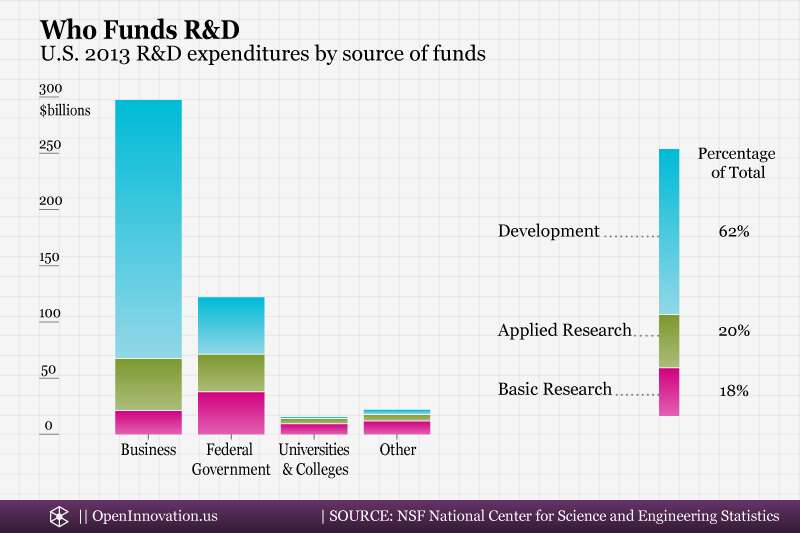
Open Business Models: How to Thrive in the New Innovation Landscape
Author: Henry Chesbrough
Publisher: Harvard Business School Press, 2006 (272 pages)
What it’s about
It's only fitting to kick off this list with a book by the "father of Open Innovation" himself. Open Business Models builds on Chesbrough’s landmark first book Open Innovation, to delve even deeper into how companies can create and capture value under this new innovation paradigm, and to showcase examples of companies opening up their business models.
The book begins with an economic justification for looking at innovation differently. Chesbrough describes a developing trend of “division of innovation of labor”, where multiple parties are involved in the process of taking an idea to market. Intermediate markets for technologies have important implications for how companies manage assets like patents and other IP. Rising costs of technology development and shorter product lifecycles also make closed models unsustainable, driving companies toward open innovation: open business models create additional sources of revenues, and save cost and time by leveraging external development.
The concept of the business model is addressed with much attention to detail throughout the book. The different functions of the business models for creating and capturing value are reviewed, and a framework is offered to categorize companies’ business models into one of six types, taking into account innovation processes and management of IP. Companies with undifferentiated business models (Type 1) operate without distinct processes for innovation and find it hard to sustain a competitive advantage. On the opposite side of the spectrum, companies with adaptive business models (Type 6) are constantly innovating their business models, and even influence the business models of the firms in their value chain. Examples and diagnostic questions provide readers with a useful starting point for assessing and advancing the business model of their own companies.
Two chapters are devoted to considering in depth two elements that shape business models: the external environment and IP management. New challenges and opportunities created by the new innovation landscape include stronger IP protection, which has led companies like Texas Instruments and IBM to manage patents more actively as a source of revenues, and the emergence of secondary markets for innovation. On the latter, Chapter 3 offers valuable guidance on how companies should manage innovation in the presence of intermediate markets, including how to exploit external innovation by scouting for technologies, tapping business networks, and cultivating relationships with universities.
What I like about it
This book makes the connection between managing innovation and managing Intellectual Property explicit. I found this especially valuable as IP tends to be an overlooked topic in most innovation books. Chesbrough offers clear evidence why companies must pay close attention to IP, and why the link between IP and the business model is essential. Underutilization of IP assets, a problem for many technology companies, is explained in the context of “closed IP management” which limits the opportunities for leveraging IP. In contrast, an open innovation approach offers a way to manage IP to create, rather than just extract, value. The emergence of IP-enabled business models also affects companies as they open up to external sources of innovation. Chapter 7 contains fascinating profiles of Qualcomm, UTEK, and Intellectual Ventures, three very different companies using IP as pure play.
Because Open Innovation is a concept that is much easier to understand than it is to put into practice, I especially liked that the author carefully considers some of the practical challenges presented by the new innovation landscape. In particular, the discussion of innovation intermediaries, a new class of firms that can help companies tackle the issues inherent in accessing external ideas and letting others use internal technologies, is very much relevant today. Companies now routinely use the services of some of the intermediaries profiled, including NineSigma and InnoCentive, as part of their open innovation efforts. Chapter 6 offers a valuable perspective in understanding the different types of such intermediaries and thinking about the value they can offer.
Should you read it?
This book should be required reading for anyone involved in open innovation. If you’re familiar with Henry Chesbrough or his other works, you’ll recognize in this book the same engaging style and nuanced approach to strategy issues. Chesbrough has interviewed many company executives and managers about their innovation processes and challenges, and these examples keep Open Business Models from ever getting too academic. The notes at the end of the book are a welcome bonus, as they offer additional insights from these discussions with practitioners among other informative comments.
Innovation managers will especially benefit from Chapter 2, which addresses internal barriers to both outside-in and inside-out open innovation. The guidance for dealing with the “Not Invented Here” and “Not Sold Here” syndromes is invaluable for companies trying to figure out how to become more open. Chapter 8 profiles three companies that have managed to open up their business models: IBM, Procter & Gamble, and Air Products. These examples offer direction for companies in how to utilize external technologies, find new sources of revenue, and deal with unused technologies.
Chesbrough summarizes the core concept of the book in one sentence:
“Companies must develop more open business models if they are to make the most of the opportunities offered by Open Innovation.”
H. Chesbrough in Open Business Models
Most companies these days can’t afford to ignore open innovation, and executives must manage their business models with an eye towards profiting from it. Open Business Models is an essential resource for innovating your business model to do just that.







